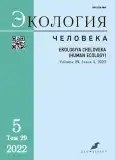Скрининговая оценка синдрома дисплазии соединительной ткани у подросткового населения Тюменской области
- Авторы: Нагаева М.О.1, Колпаков В.В.1, Ослина А.Н.1, Томилова Е.А.1, Беспалова Т.В.2
-
Учреждения:
- Тюменский государственный медицинский университет
- Ханты-Мансийская государственная медицинская академия
- Выпуск: Том 29, № 5 (2022)
- Страницы: 311-321
- Раздел: ОРИГИНАЛЬНЫЕ ИССЛЕДОВАНИЯ
- URL: https://journal-vniispk.ru/1728-0869/article/view/96622
- DOI: https://doi.org/10.17816/humeco96622
- ID: 96622
Цитировать
Полный текст
Аннотация
Введение. Необходимость проведения полномасштабных эпидемиологических исследований распространенности дисплазии соединительной ткани (ДСТ) у населения различных климатических регионов вызвана тем, что это нарушение способствует формированию и развитию многообразных патологических состояний, неблагоприятно влияющих на качество и продолжительность жизни.
Цель. Определение распространенности и структуры синдрома недифференцированной ДСТ среди подростков, проживающих в различных климатогеографических зонах Тюменской области.
Методы. В одномоментное обсервационное исследование на территории Тюменской области (ТО), Ханты-Мансийского автономного округа — Югры (ХМАО-Югры), Ямало-Ненецкого автономного округа (ЯНАО) включено 578 подростков обоих полов ключевых возрастных групп (12 и 15 лет). Оценка фенотипических признаков синдрома недифференцированной ДСТ осуществлялась в соответствии с клиническими рекомендациями Российского научного медицинского общества терапевтов по диагностике, лечению и реабилитации пациентов с дисплазиями соединительной ткани. Определялась распространенность, структура и выраженность синдрома недифференцированной ДСТ.
Результаты. На территории ТО с автономными округами распространенность недифференцированной ДСТ среди обследованных подростков составила 58,5%. Распространенность недифференцированной ДСТ на юге ТО составила 52,3%, на территории ХМАО-Югры — 61,6%, на территории ЯНАО — 65,3%. К наиболее часто регистрируемым фенотипическим признакам ДСТ относились: гипермобильность суставов; сколиоз позвоночника; гиперкифоз грудного отдела позвоночника; синдром прямой спины; индекс Варги 1,5–1,7; астеническая грудная клетка; аномалии прикуса; дисморфизм ушных раковин; «готическое» небо; дряблая, вялая кожа; миопия. О значительной выраженности синдрома ДСТ у обследованных свидетельствует высокий средний диагностический коэффициент — 35,46±0,05 балла, превышающий диагностический порог более чем в 2 раза. Не выявлено отличий в выраженности ДСТ по ряду прогностически значимых критериев в зависимости от климатогеографических условий внутри исследуемого региона.
Заключение. Необходимо учитывать высокую распространенность и выраженность ДСТ у подростков, проживающих на территории Тюменской области при планировании программ лечебно-профилактических и реабилитационных мероприятий.
Полный текст
Открыть статью на сайте журналаОб авторах
Марина Олеговна Нагаева
Тюменский государственный медицинский университет
Автор, ответственный за переписку.
Email: nagaeva_m@mail.ru
ORCID iD: 0000-0003-0835-3962
SPIN-код: 6952-4984
канд мед. наук, доцент
Россия, г. ТюменьВиктор Васильевич Колпаков
Тюменский государственный медицинский университет
Email: kolpakov661@rambler.ru
ORCID iD: 0000-0001-6774-0968
SPIN-код: 6672-1697
д-р мед. наук, профессор
Россия, г. ТюменьАлександра Николаевна Ослина
Тюменский государственный медицинский университет
Email: 0777@mail.ru
ORCID iD: 0000-0001-7846-8605
SPIN-код: 7089-1798
Россия, г. Тюмень
Евгения Александровна Томилова
Тюменский государственный медицинский университет
Email: tomilovaea@mail.ru
ORCID iD: 0000-0003-1101-7628
SPIN-код: 4006-9259
д-р мед. наук, доцент
Россия, г. ТюменьТатьяна Викторовна Беспалова
Ханты-Мансийская государственная медицинская академия
Email: tatianadmn@mail.ru
ORCID iD: 0000-0002-7210-0946
SPIN-код: 7314-3598
д-р мед. наук, доцент
Россия, г. Ханты-МансийскСписок литературы
- Вершинина М.В., Нечаева Г.И., Гудилин В.А. Относительный сердечно-сосудистый риск у пациентов молодого возраста с дисплазией соединительной ткани // Терапия. 2020. № 6. С. 40–45. doi: 10.18565/therapy.2020.6.40-44
- Мартынов А.И., Нечаева Г.И., Акатова Е.В., и др. Национальные рекомендации Российского научного медицинского общества терапевтов по диагностике, лечению и реабилитации пациентов с дисплазиями соединительной ткани // Медицинский вестник Северного Кавказа. 2016. №1. С. 2–76. doi: 10.14300/mnnc.2016.11001
- Coles W., Copeman A., Davies K. Hypermobility in children // Pediatrics and child health. 2018. Vol. 28, N 2. P. 50–56. doi: 10.1016/j.paed.2017.12.001
- Feise R.J, Donaldson S., Crowther E.R., et al. Construction and validation of the scoliosis quality of life index in adolescent idiopathic scoliosis // Spine (Phila Pa 1976). 2005. Vol. 30, N 11. P. 1310–1315. doi: 10.1097/01.brs.0000163885.12834.ca
- Scheper M.C., Pacey V., Rombaut L., et al. Generalized hyperalgesia in children and adults diagnosed with hypermobility syndrome and ehlers-danlos syndrome hypermobility type: a discriminative analysis // Arthritis Care Res (Hoboken). 2017. Vol. 69, N 3. P. 421–429. doi: 10.1002/acr.22998
- Глотов А.В., Добрых С.В., Иванова Е.А., Плотникова О.В. Дисплазия соединительной ткани у лиц подросткового возраста: экспертиза профпригодности, профилактика и восстановительная коррекция. Омск: Омская государственная медицинская академия, 2014. 208 с.
- Карпин В.А. Медицинская экология Севера: актуальность, достижения и перспективы (обзор литературы) // Экология человека. 2021. Т. 28, №8. С. 4–11. doi: 10.33396/1728-0869-2021-8-4-11
- Стародед А.С., Майдан В.А., Цветков С.В. Влияние медикогеографических особенностей Крайнего Севера на процессы адаптации // Известия Российской Военно-медицинской академии. 2020. Т. 39, № S3-5. С. 160–163.
- Bjerregaard P., Young T.K., Dewailly E., Ebbesson S.O. Indigenous health in the Arctic: an overview of the circumpolar Inuit population // Scand J Public Health. 2004. Vol. 32, N 5. P. 390–395. doi: 10.1080/14034940410028398
- Jolly S.E., Howard B.V., Umans J.G. Cardiovascular disease among Alaska Native peoples // Curr. Cardiovasc. Risk Rep. 2013. Vol. 7, N 6. P. 1–10. doi: 10.1007/s12170-013-0362-5
- Sharma S., Barr A.B., Macdonald H.M., et al. Vitamin D deficiency and disease risk among aboriginal Arctic populations // Nutrition Reviews. 2011. Vol. 69, N 8. P. 468–478. doi: 10.1111/j.1753-4887.2011.00406.x
- Stenlund P. The Arctic Council and health issues // International Journal of Circumpolar Health. 2002. Vol. 2, N 61. P. 88–91. doi: 10.3402/ijch.v61i2.17409
- Кадурина Т.И., Гнусаев С.Ф., Аббакумова Л.Н., и др. Наследственные и многофакторные нарушения соединительной ткани у детей. Алгоритмы диагностики. Тактика ведения // Медицинский вестник Северного Кавказа. 2015. Т. 10, №1. С. 5–35. doi: 10.14300/mnnc.2015.10001
- Яковлев В.М., Нечаева Г.И., Мартынов А.И., Викторова И.А. Дисплазия соединительной ткани в практике врачей первичного звена здравоохранения: руководство для врачей. М.: КСТ Интерфорум, 2016. 520 с.
- Онуфрийчук Ю.О., Рагозин О.Н., Радыш И.В., Журавлева Ю.С. Дисплазия соединительной ткани: распространенность и спектры фенотипических проявлений в различных климатических поясах // Экология человека. 2009. Т. 16, №1. С. 29–33.
- Glesby M.J., Payeritz R.E. Association of mitral valve prolapse and systemic abnormalities of connective tissue. A phenotypic continuum // JAMA. 1989. Vol. 262, N 4. P. 523–528.
- Викторова И.А. Методология курации пациентов с дисплазией соединительной ткани семейным врачом в аспекте профилактики ранней и внезапной смерти : дис. …д-ра мед. наук. Омск, 2004. 462 с.
- Ермачкова В.Л., Ховаева Я.Б., Головской Б.В. Психосоматические особенности лиц молодого возраста с синдромом дисплазии соединительной ткани по результатам диспансерного осмотра // Кубанский научный медицинский вестник. 2009. №6 (111). С. 45–47.
Дополнительные файлы








